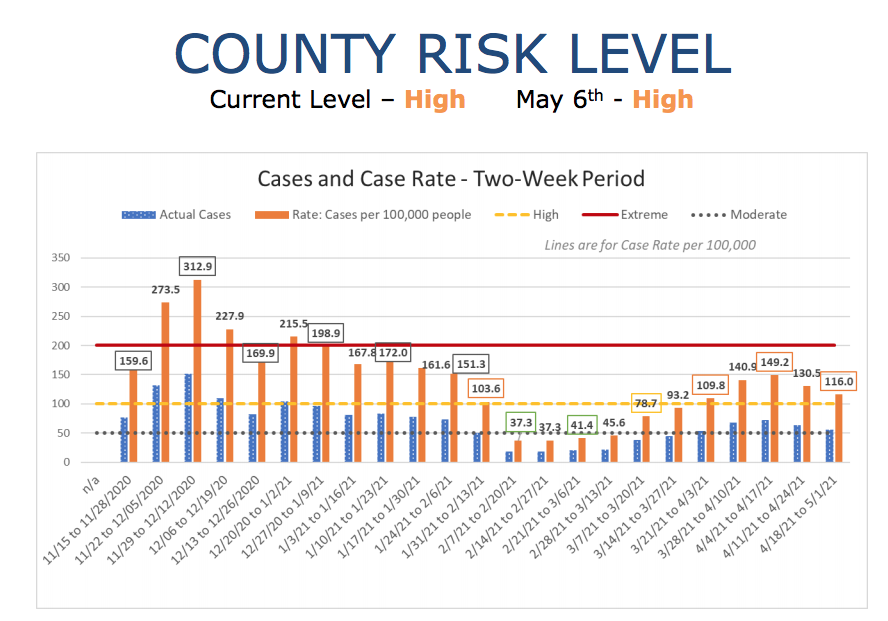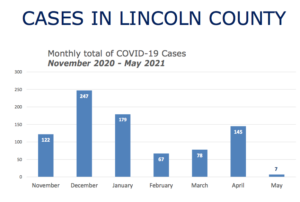
By GARY A. WARNER/Oregon Capital Bureau
The indoor dining ban and other major restrictions under COVID-19 rules will be lifted Friday for 15 counties because a key metric was missed by 0.1%.
Gov. Kate Brown announced late Tuesday that 15 counties put on the extreme risk level for spread of the virus — the highest of the four-tier risk levels — could operate under the high risk standards instead.
“Oregon no longer meets the statewide metrics,” Brown said in a statement.

The extreme risk level shuts down indoor dining, limits crowd sizes, caps entertainment and exercise activities and requires most businesses to close by 11 p.m. Visits to residents of nursing homes are curtailed. Under high risk, restaurants can offer indoor dining and other restrictions are loosened.
Lincoln County is in the “high risk” category and will stay there – missing from moving to the “moderate” level by six COVID-19 cases the past week.
“For us, we’re going in the right direction,” Lincoln County Public Health spokeswoman Susan Trachsel told county commissioners Monday. “If we had six fewer cases we could have gone down to moderate.”
Brown’s statement ended a confusing delay of several hours beyond the normal release of risk level ratings.
In early April, when infections were on the wane, Brown announced that counties that would normally be in the extreme risk level could stay at the high risk level as long as hospitalizations statewide didn’t top 300. The policy also required that hospitalizations rise more than 15 percent to keep the severe limits in place.
The period on which risk levels will be based beginning Friday is from April 18 to May 1. Oregon saw a statewide rise in infections. The state had 11,266 cases — 265.9 per 100,000. Positive tests made up 6.4% of all results.

But on Tuesday, hospitals reported 345 COVID-19 patients, and the percentage growth of hospitalizations was pegged at 14.9%. The .1% miss led to a major policy u-turn.
“Based on today’s numbers, I am keeping my commitment to Oregonians,” Brown said.
As of Friday, no counties will be under extreme risk limits. The new numbers put 24 counties at high risk, four at moderate risk, and eight at lower risk.
Oregon Health Authority projections show the state can handle the current rate of demand for hospital beds.
Brown also said she did not expect the state to move back to the extreme level again at any point. The state is expecting a major increase in vaccine shipments from the federal government.
“Vaccinations are still our best path to protecting our loved ones, and staying on track to fully reopen our economy by the end of June,” Brown said
Political friction in Oregon has increased with Brown’s extreme risk decision and again extending her emergency powers, first put in place in March 2020, through at least June 28.
In the most concrete bid to curb Brown’s authority, the House voted 28-27 Tuesday against a motion to consider a bill that would give the Legislature a larger say in governor’s declarations of emergency.
“Oregonians deserve a balance of power between their separate branches of government again,” said House Minority Leader Christine Drazan, R-Canby.
Brown and the Oregon Health Authority Director Pat Allen have pointed to Oregon’s safety during the pandemic that has killed over 575,000 Americans. Oregon has had the third lowest per capita number of cases in the nation, at 4,432 per 100,000 during the entire pandemic.
Brown will next announce any revisions in risk levels Tuesday, May 11.
County Risk Categories, Effective May 7 – 13
Lower Risk (8): Gilliam, Harney, Lake, Morrow, Sherman, Union, Wallowa and Wheeler;
Moderate Risk (4): Coos (Moved from High), Curry, Hood River (Moved from High), and Tillamook;
High Risk (24): Baker (Moved from Extreme), Benton, Clackamas (Moved from Extreme), Clatsop, Columbia (Moved from Extreme), Crook (Moved from Extreme), Deschutes (Moved from Extreme), Douglas (Moved from Moderate), Grant (Moved from Extreme), Jackson (Moved from Extreme), Jefferson, Josephine (Moved from Extreme), Klamath (Moved from Extreme), Lane (Moved from Extreme), Lincoln, Linn (Moved from Extreme), Malheur (Moved from Moderate), Marion (Moved from Extreme), Multnomah (Moved from Extreme), Polk (Moved from Extreme), Umatilla, Wasco (Moved from Extreme), Washington, and Yamhill
Extreme Risk (0)
- Quinton Smith of YachatsNews.com contributed to this report


